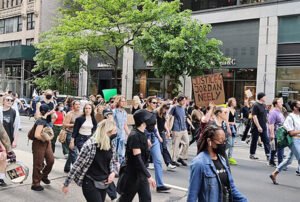
Many of the big nonprofit stories of 2014 are obvious and palpable—big chewy knots of things that require an “all hands on deck” kind of attitude with lots of room for failure and success. The cross-cutting theme is that these issues are all connected to one another, implying that this is a moment with real possibilities for change. There is a measure of real chaos combined with great energy, and in that chaos, perhaps the potential for new organizing principles.
This, by the way, is not an exhaustive list; feel free to add your own observations.
New Era Changes
1. Technology and Millennials continue to transform the nonprofit sector. Technology and those who have grown up with it have inexorably altered the fabric of our lives and processes of our work, changing our relationships to constituents, stakeholders, and information. Our ability to access and even add to information we need to advance our causes and programs is enormously enhanced. These changes pose challenges in terms of institutional cultures and practices. They bring with them enhanced expectations for the reciprocity of forthcoming transparency, consultation and input.
Much of what nonprofits use technology for involves the Web, and some argue that it should be considered a public utility—a combination of public square, access to markets, and so much more—accessible in a neutral way to all who need it. This requires that levels of access cannot be bought or sold by corporations who have been pushing for a “fast lane.” In 2014, many different kinds of organizations, including the Ford Foundation, weighed in on net neutrality, although there have been some odd alliances that have created some dissidence in the sector with regards to reclassification of the net as public utility.
Growing up with technology has also, it seems, changed the paradigms of social justice organizing. This morning’s newswires include one about old/new concepts of leadership in the protests around the shootings of young black men. In that, Matthew C. Whitaker, director of the Arizona State University Center for the Study of Race and Democracy, is cited saying that times have legitimately changed as far as how a movement may be kept of a piece.
Social media may in some ways replace the role of a traditional leader or organization, so the fact that some young people would reject the idea of a central standard-bearer makes some sense, Whitaker said. The protestors prefer “leadership that’s shared and that doesn’t rely so much on one major leader, because history has shown we kill those leaders,” he said. “We marginalize them. We undermine their reputation. We do something to undermine their ability to execute and lead. And, as a result, vacuums are left and the movement crumbles.”
We have seen this phenomenon consistently enough in recent organizing here and abroad that we ought to just stop insisting the old “one charismatic hero” way is the only way to manage a movement. Is an old narrative giving way?
Governance practices must change as a result of technology’s advance, if only out of an understanding that your organization’s stakeholders are far more able to connect and organize if they believe the organization’s board is not making good decisions. This kind of organizing has occurred recently around many performing arts groups where, for instance, musicians, local elected officials, and donors have the opportunity to connect. We have seen board decisions reversed, labor negotiations affected, and new kinds of contracts developed.
This is not a phenomenon exclusive to the nonprofit sector. NPQcovered the Market Basket story this year, where a leadership decision made by the board of a popular grocery chain was met with combined resistance from employees and customers, forcing a reversal. Technology allows for an easier connecting of complementary interests in common cause.
In the face of this, it is the careless nonprofit that does not 1) put its ear to the digital ground, where issues with the organization are likely being discussed long before they pose a real challenge to decisions already made, and 2) discuss potentially problematic issues with stakeholders ahead of time. This changes the duties and conceptual frameworks of governance.
Which Social Issues are at a “Tipping Point?”
2. The federal government has largely abdicated its on-and-off role as driver of social change. The federal government, beset by gridlock, is, as far as the economy is concerned, still fiddling around with cronies willing to finance electoral campaigns as Rome becomes increasingly disenfranchised. In its gridlock, the federal government is seen as incapable of being centrally powerful as a driver of societal change. So many changes are happening at the state and local levels, and some are driven by movements: pro- and anti-abortion, pro- and anti-gay marriage, pro- and anti-legalization of marijuana, pro- and anti-death penalty. What else might be accomplished in this way, and with what kinds of coalitions?
In the midst of all of this abdicating, by the way, was the continuing saga with the IRS’s handling of applications for nonprofit status. This issue lingers, and in the meantime the budget for the IRS’ monitoring of nonprofits has been slashed, pushing even more of the responsibility for enforcement to the state attorney general level, where the budgets for monitoring this sector and will to act vary enormously. Some states have made monitoring of this sector a priority, of course, as in New York.
3. Race-based injustice comes to a head. The end of this year saw a rash of large, multicultural, multi-generational, multi-state protests, making immediate an issue that is by no means new: the disproportionate number of shootings of black men by police officers. Although this may have been the obvious flashpoint, the sheer numbers hammered a crack in the wall of cultural denial, leading the country to once again pay attention to the myriad effects of structural racism.
Simultaneously, attention has been drawn to the lack of diversity in our own organizations. A report published about the country’s large environmental nonprofits exposed a lack of progress in that sector, but there is no indication that the rest of the sector is much better at inclusion, particularly of people of color. GuideStar, for instance, has declared that it will be collecting diversity data. At the very end of the year, a reader contributed an article, “The Nonprofit Sector Has a Ferguson Problem,” which was a strong call to internal action in nonprofits.
4. Inequality and stagnating wages are trending inexorably in the wrong direction. In innumerable studies this year, we have been treated to clear metrics about the widening chasm of income inequality. This has only worsened since the end of the recession, as we detailed in this newswire, with most of the fruits of the economic rebound going to the top echelons of asset holders. Meanwhile, wages continue to stagnate. Major corporations were exposed at the end of 2013 for paying wages that were so low that employees required government subsidies to cover even the basics.
There has been some movement on minimum wages at the state and federal levels that exhibit some concessions, but even these only address the lowest echelon of workers, leaving out millions of others who are making more than the minimum wage but struggle while the rich become ever richer. Based on actions in 2014, 21 states begin 2015 with new minimum wage requirements. That’s more than “some movement”; you could say it’s not enough, or that the U.S. has, even with those increases, the lowest minimum wage among western countries (though we beat Uganda—the minimum wage there, unbelievably, is 6,000 Ugandan shillings per month, or around $2.16). Nonprofits, of course, are not blameless in wage issues. There are many nonprofits that have fought for waivers in living wage requirements.
As we said earlier, the issues interconnect, and in this case, a look at the race-based divergence between the wealth of African American vs. white households has had light shone upon it.
5. Criminal justice reform is finally back on the agenda, and this time with bipartisan interest. This attention has focused largely on the United States’ massive rate of imprisonment and the contribution of the so-called “War on Drugs” and mandatory sentencing to that phenomenon. There is an enormous racial component in this issue as well, with wide disparities in arrests and sentencing etc. Many nonprofit advocacy and legal organizations have been steadily producing data, making noise, and further building out the case for such movement during decades of the most unfriendly of policy and public opinion environments. This is, by the way, an invaluable role of nonprofits: advocating for social justice over periods when it appears that little positive can be achieved, at least in terms of legislation.
The death penalty movement is also seeing progress. The Death Penalty Information Center in its year-end report informs us that there were 35 executions nationwide in 2014—a 10 percent decrease, and the lowest number since 1994. The 72 new death sentences imposed this year were the fewest since 1974. There were any number of nonprofit contributors to this trend, but in general Americans have grown more skeptical of capital punishment. The number of states carrying out executions—seven—was the lowest in 25 years, and just three states (Texas, Missouri, and Florida) accounted for 80% of the executions.
The Marshall Project, a media effort solely focused on criminal justice issues, launched as a new nonprofit news site under the leadership of Bill Keller, former editor of the New York Times, to provide consistent coverage and deep context to those working in this area. This is interesting in part because it is a new form for “fourth estate” journalism.
Government/Nonprofit Interrelationships
Sign up for our free newsletters
Subscribe to NPQ's newsletters to have our top stories delivered directly to your inbox.
By signing up, you agree to our privacy policy and terms of use, and to receive messages from NPQ and our partners.
6. The implementation of the Affordable Care Act was largely designed around a strong nonprofit role, and at the end of the first year, we can see some of the early results of that through the dedicated and unique coverage of Rick Cohen and Michael Wyland—but the picture is complex.
At the end of the year, Cohen published a thorough study of the performance and competitive challenges of the new nonprofit health co-ops. The co-ops received billions in capital loans and grants to build a viable “business” in a very competitive market within less than two years and were largely enormously successful.
And in the meantime, many nonprofit hospitals struggled in innumerable ways to get re-established in a new environment. The regulations of nonprofit hospitals changed to some extent, getting more explicit about requirements around community benefits and charity care. Some of the most excruciating stories this year have been focused on collection practices, accessibility, and other concerns that call into question the tax exemption.
Of course, billions in federal money was used to build up community health centers as a cornerstone institution for the ACA, with the understanding that they would be able to act as primary care providers for the newly insured, thus providing them with a base of revenue that would sustain them over time. But, as with most grand plans, the way things played out differed from what was expected, in part due to the fact that many states did not avail themselves of Medicaid expansion. This may perversely destabilize parts of that safety net network which has recently been built up (thus raising fixed costs) unless the centers face facts squarely and remake their plans if possible, perhaps reducing planned buildouts or by developing other aligned product lines.
7. New relationships between government and philanthropy were exemplified by Detroit’s Grand Bargain, which is explained here by Rip Rapson of the Kresge Foundation. The Grand Bargain may be unique in many respects due to Detroit’s massive bankruptcy, but foundations are playing more constructive and continuing roles in partnerships with government—for good sometimes, perhaps not in others. Foundation roles this past year have included foundation involvement in the Department of Education’s Race to the Top, the Corporation for National and Community Service’s Social Innovation Fund, and many more governmental programs. The challenge for foundations, particularly those intertwined with federal efforts, has been to remember that philanthropy remains—or should remain—fundamentally capable of being a counterweight (through its funding of nonprofits) to government and able to prioritize building the third sector’s ability to criticize and challenge government as it does the for-profit sector, and lose philanthropy’s identity as a handmaiden to government partnerships.
How Business is Done Now
8. Arts Institutions and other capital structures struggle to fit into changed markets. For some kinds of organizations, market circumstances have changed so drastically that restructuring is the word of the day. These re-examinations have been particularly public when it comes to high-profile performing arts organizations, as mentioned above. Restructuring in some cases has involved a new look at how to interact with market/community/audiences, a new look at fixed to variable costs, an emphasis on renewable and multiple-use assets, and a new look at the power of stakeholders.
For instance, the Minnesota Symphony is a strong example of the power of connected stakeholder groups. In this case, the Orchestral Association was able to save its relationships and standing with stakeholders directly in advance of what looked like a planned coup, but pressure from those stakeholders resulted in the firing of the CEO.
Another of these re-examinations resulted in an unusual clause in the new contract between the Metropolitan Opera and its unions that requires that the union have access to the financials of the opera in the same way that board members do. This phenomenon relates back to the prior observations I made in item 1 on the changing face of governance.
Arts organizations are not the only ones adjusting to distinctly new market and capital structure conditions. Community health organizations are in similar positions, often with heavier fixed costs (as a result of federal capital investments) against a market that is as yet unsure (see item 6).
9. U.S. social enterprise is stuck in some very old assumptions while claiming to be new. Many of today’s social enterprise start-ups are wrought in the image of traditional business. They are the brainchildren of privileged individuals who persuade other privileged individuals to provide them with money to benefit others. In fact, this merely mirrors old assumptions about social leadership and “ownership.”
In “Celebrating Small Batch Social Enterprise,” Brian Cognato says that this kind of “hero entrepreneur” image is the dominant narrative, but he posits an alternative that should perhaps be this sector’s default:
“There is an alternative story, however; and, though probably familiar to practitioners, it lacks the broad audience of heroic social enterprise—at least in the United States. It is a story defined by modesty and locality, one that may be familiar to today’s artisan craftspeople and makers (thus the term used here, ‘small batch’). In this story, the protagonist isn’t an individual but rather an entire community, and sustainable, incremental improvement is as valid a goal as the dramatic resolution of a specific problem. The community finds a way to make market forces serve their goals, unlocking underutilized potential for context-specific progress. It is a story that recognizes that some solutions need to be custom-made, and that market forces are a means, not an end. It’s a story that often lacks a charismatic entrepreneurial figure, instead finding the potential for social change in collaboration among diverse groups. While new paradigms and scale are possible in small batch social enterprise, it also recognizes that seemingly small advances in things like community wealth, income, and dignity have real value to those who benefit from them.
“This is the story of co-ops and Community Development Corporations (CDCs), and the partner neighborhoods of Enterprise Community Partners, which attempts to bridge the private and public sectors to develop affordable housing in thriving communities. Art Enables, which showcases the art of individuals with disabilities, is an example in this writer’s home of Washington, D.C. Much of this article was written in a coffee shop operated by Oriberry, a small batch social enterprise that sells high-quality coffee through direct partnerships with farmers in Vietnam’s rural highlands. If these aren’t household names, that shouldn’t be surprising: when you partner individually with low-resource farmers, growth is slow, at best. But, as Anna Davies has pointed out, growth shouldn’t be an end in and of itself. By swapping locality for scale, small batch social enterprises can achieve a sustainable impact while forgoing wide recognition.”
In general, we wish people would consider the real differences in accountability and governance that are and should be different between the sectors. This newswire on the five bad reasons to choose a for-profit social enterprise over a nonprofit gets to some of that.
Social impact bonds appear to have been the new nonperforming battleground this past year, but we have also published definitive material on the performance of benefit corporations and L3Cs.
Oligarchy vs. The Masses
10. Showy billionaire philanthropy is increasingly seen as a problem that mirrors and brings the wealth gap to bear on the nonprofit sector. While NPQ has generally been among a very few in seeing billionaire philanthropy as a problem, we are now finding ourselves in more company. This year, even Patrick Rooney of IUPUI and Giving USA suggested that the era of mega-gifts was skewing not only the giving stats but the array of recipients.
In short, rich people tend to give to already rich institutions, so although giving may be recovering after the big recession, it is apparently recovering in an image that mirrors the larger economy; that is, much of the fruits of the recovery go to those who already have large endowments and huge budgets, with smaller organizations, more unfamiliar to larger givers, going wanting.
But when billionaires do weigh in in less moneyed environments, they may overwhelm other investors or even nation states, and this may sometimes direct the responses of public systems to public problems. Over and over, Bigfoot is invited to dinner, but does not necessarily know how to act.
One of the most obvious and egregious examples of this was in the funding of a big data education project, InBloom, that subsequently went belly up within a year after parents, probably fairly predictably, asserted that they did not want information on their children gathered and centrally stored. This was one of any number of similar investments that constituted a trend in billionaire giving. Finally, some of those enormous grants have been poured down drains in ways that imply an appalling lack of due diligence and respect for community.
11. New Legitimacy of Social Protest. Social protest is on the rise in a myriad of ways and among people who never expected to involve themselves in such stuff. It is aided by technology and the ability of stakeholder groups to be in contact with each other around issues of common concerns. The most recent fractals of protests around police shootings of black men are one example, but so are the more local Market Basket protests where customers, employees and lawmakers all made themselves heard to good effect.
The structure of the protests against police shootings of black men is relatively loose and rolling, measured, broad-based, and self-organizing. Can they survive and develop steady agendas that don’t break down under the usual internal and external stresses? Is it, or can it become, a movement with the longevity needed for long-lasting change?
One interesting aspect of the new protests is the purposely diffuse nature of leadership, as was so beautifully described, warts and all, in this article from one of those who participated in last year’s democracy protests in Hong Kong.
The progress of these efforts will be faced with predictable problems, like the skilled rhetorical manipulations, in the case of the New York police, of so-called leaders, but this year has been notable for the steady though diffuse refusal of loose coalitions to let go of issues that have come to a head. Also notable was the philanthropic intervention made on behalf of protestors after the Grand Jury decision in Ferguson.
All in all, it has been an eventful year with many consequences, and the fruits of what we have written upon on here remain to be identified. We welcome your thoughts on all of these trends and stories and, as always, invite your contributions in either comment or article form.













